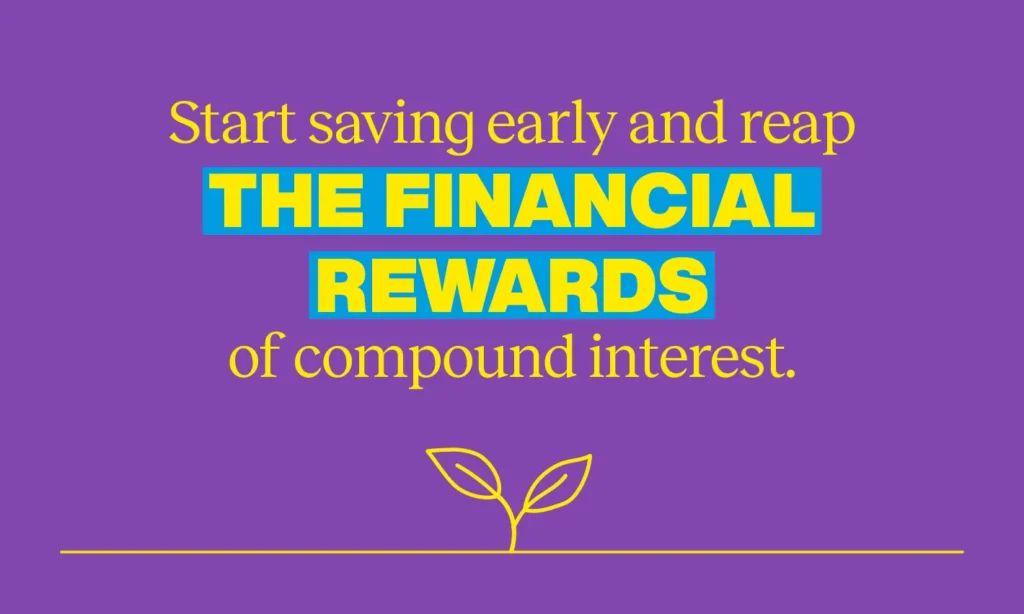Did you know that $10,000 invested at 8% would grow to over $100,000 in 30 years with compound interest, compared to just $34,000 with simple interest? This remarkable growth isn’t magic—it’s math. Yet, many Americans fail to harness this financial superpower when planning for their future.
Often called the “eighth wonder of the world,” compound interest transforms modest retirement savings into substantial wealth over time. It works by earning returns not just on your initial investment, but also on the growth that accumulates year after year.
The beauty of this concept lies in its accessibility. You don’t need to be wealthy or financially savvy to benefit from it. What you do need is time and consistency. Starting early with even small contributions can lead to significant results through the power of compound interest working in your favor.
For those engaged in retirement planning, understanding this principle isn’t just helpful—it’s essential. The difference between comfortable golden years and financial stress often comes down to whether you’ve allowed compound growth to work its full potential.
Key Takeaways
- Starting early with retirement investments dramatically increases your final balance through compound growth
- Even small monthly contributions can grow to substantial sums over decades
- Waiting just 15 years to begin investing can cut your potential retirement wealth by more than half
- Compound interest earns returns on both your principal and accumulated interest
- Consistent contributions are more important than trying to time the market
- Tax-advantaged accounts enhance the compound effect by sheltering growth from taxes
What is Compound Interest?
Compound interest is a mathematical phenomenon that enables your capital to expand exponentially, earning returns on both your initial investment and the accrued interest. This financial concept hinges on a straightforward principle: as your investment generates earnings, those earnings themselves commence generating additional returns.
Unlike simple interest, which calculates returns solely on your original principal, compound interest exhibits a multiplier effect. With each compounding period, your investment base enlarges, accelerating your wealth accumulation over time.
The Fundamental Difference
To fully comprehend compound interest, it is essential to discern its distinction from simple interest:
- Simple interest: Calculated only on the initial principal amount
- Compound interest: Calculated on the principal plus all accumulated interest
This distinction, though seemingly minor at first glance, yields dramatically disparate outcomes over time. The longer your capital remains invested, the more pronounced this difference becomes.
Let’s examine a practical example to illustrate this concept. Imagine you invest $10,000 at an annual interest rate of 7%. After 30 years, here’s how your investment would grow under each scenario:
| Year | Simple Interest | Compound Interest | Difference |
|---|---|---|---|
| 1 | $10,700 | $10,700 | $0 |
| 10 | $17,000 | $19,672 | $2,672 |
| 20 | $24,000 | $38,697 | $14,697 |
| 30 | $31,000 | $76,123 | $45,123 |
The table illustrates the widening gap between simple and compound interest over time. After 30 years, compound interest yields more than double the return of simple interest on the same initial investment.
Significance for Retirement Planning
The exponential growth pattern of compound interest renders it invaluable for retirement wealth accumulation. Most Americans spend 30-40 years in the workforce before retiring, providing an ideal timeframe for compound interest to work its magic.
We often refer to this as the “time value of money” – the concept that a dollar today is worth more than a dollar in the future due to its earning capacity. This principle underpins successful retirement planning.
When you invest for retirement through vehicles like 401(k)s, IRAs, or other long-term accounts, you’re not merely setting aside money. You’re leveraging the power of compound interest to transform modest contributions into substantial wealth over decades.
The compound interest benefits extend beyond mere mathematics. This growth mechanism also offers a psychological advantage – once you grasp how compound interest operates, you’re more inclined to initiate saving earlier and maintain consistent investment habits, both critical for retirement success.
As we’ll explore in the next section, the true power of compound interest becomes even more evident when examining its effects over extended time periods. The synergy between time and compound growth opens up opportunities for retirement planning that are inaccessible through other financial strategies.
The Power of Compounding Over Time
In the realm of retirement savings, time emerges as an invisible multiplier, transforming compound interest into a formidable financial ally. This synergy between time and compound interest constitutes a potent mechanism for wealth accumulation accessible to the masses.
The notion of the “time value of money” elucidates why a present-day dollar possesses greater value than its future counterpart. This disparity transcends mere inflationary considerations—it encompasses the inherent earning capacity of invested capital. A dollar invested today commences its work immediately, generating returns that, in turn, produce additional returns.
It is a fundamental truth that the longer your money compounds, the more dramatic its growth becomes. This phenomenon defies linear progression, instead manifesting as exponential growth, with an initial slow ascent that rapidly intensifies over time.
Effects of Starting Early
The disparity between initiating retirement savings at age 25 versus 35 or 45 is profound. This disparity extends beyond mere additional years of contributions—it also grants compound interest a longer period to exert its influence.
Consider a concrete illustration. Three individuals aim to accumulate retirement savings:
- Alex commences investing $5,000 annually at age 25
- Bailey initiates investing $10,000 annually at age 35
- Casey commences investing $15,000 annually at age 45
With a 7% average annual return, by age 65, their accounts exhibit striking disparities. Despite contributing less overall, Alex’s early commencement affords a significant advantage that Bailey and Casey cannot surmount, even with larger contributions.
| Investor | Starting Age | Annual Investment | Total Contributed | Account Value at 65 |
|---|---|---|---|---|
| Alex | 25 | $5,000 | $200,000 | $1,068,048 |
| Bailey | 35 | $10,000 | $300,000 | $1,010,730 |
| Casey | 45 | $15,000 | $300,000 | $608,131 |
The Snowball Effect
Compound interest engenders a “snowball effect.” Like a snowball rolling downhill, your investment grows not just in size but in its capacity to generate even more growth as it progresses through time.
In the early stages of saving, most account growth stems from contributions. A critical juncture is reached where the interest generated by your account surpasses your annual contributions. This marks the zenith of compound interest’s potency.
For instance, in a retirement account earning 7% annually, after approximately 10 years, the annual interest earned commences to rival your contributions. By year 20, the interest often surpasses what you’re contributing. And by year 30, the interest can generate multiple times your annual contribution amount.
Compound interest is the eighth wonder of the world. He who understands it, earns it; he who doesn’t, pays it.
This acceleration underlines the importance of patience and consistency in achieving long-term financial objectives. The most pronounced growth occurs in the latter years of your investment timeline, underscoring the significance of an early start.
A year-by-year analysis of a hypothetical $5,000 annual investment illustrates this principle vividly. In the first decade, contributions dominate the account value. By the third decade, compound interest assumes the primary role in growth.
By grasping how compound interest magnifies over time, you can refine your retirement savings strategy. The takeaway is unequivocal: time in the market is a quintessential asset in your retirement planning arsenal.
Key Factors Influencing Compound Interest
The intricacies of compound interest are underpinned by three critical variables, each capable of significantly influencing your retirement investment outcomes. Mastery over these elements empowers you to refine your retirement investment strategies, enabling more informed decisions regarding your financial trajectory.
Principal Amount
The principal amount serves as the cornerstone of your investment, encompassing both your initial deposit and any subsequent contributions. This foundational element exerts a profound influence on your long-term financial prospects.
Incremental increases in regular contributions can lead to substantial variations in your final savings balance. For instance, augmenting your monthly contribution by $100 (from $400 to $500) over 30 years at a 7% annual return would augment your retirement savings by approximately $122,000.
Investors often ponder whether to invest a lump sum or adopt a periodic investment strategy. Historically, lump-sum investing has outperformed dollar-cost averaging about two-thirds of the time. Yet, periodic investments offer psychological advantages and are more accessible for most individuals who receive regular income.
Interest Rate
The interest rate or rate of return on your investments is the most influential factor in the compound interest equation. Even minor variations in rates can lead to vastly different outcomes over extended periods.
Consider these realistic expectations for different investment vehicles:
- High-yield savings accounts: 3-5% annual returns
- Government and corporate bonds: 4-6% average returns
- Stock market investments: 7-10% historical average annual returns
- Diversified retirement portfolios: 5-8% depending on asset allocation
The disparity between a 5% and 8% return might seem negligible, yet over 30 years on a $100,000 investment, it translates to a difference of over $600,000 in your final balance. This underlines the significance of judicious investment selection in effective retirement investment strategies.
Compounding Frequency
The frequency at which interest is calculated and added to your principal introduces another dimension of growth. More frequent compounding enhances returns, even with identical annual interest rates.
For example, $10,000 invested at 6% annual interest would grow to these amounts after 30 years:
- Annual compounding: $57,435
- Quarterly compounding: $60,226
- Monthly compounding: $60,970
- Daily compounding: $61,159
When evaluating investment options, it is essential to consider the “effective annual yield” instead of the stated interest rate. This metric accounts for compounding frequency, providing a more accurate representation of an investment’s growth capability.
The control over these factors is what makes them so empowering. You can augment contributions through budget adjustments, select investment vehicles with higher growth potentials (considering risk tolerance), and opt for accounts with more frequent compounding.
Optimizing these three variables can significantly amplify the impact of compound interest on your retirement nest egg. The most effective strategy often involves maximizing all three: consistent contributions, reasonable growth rates, and the leverage of frequent compounding.
Why Start Saving Early?

The intricacies of compound interest unveil a profound truth: those who initiate saving early possess a financial advantage that eludes late starters. This disparity is not trivial; it profoundly alters one’s retirement prospects. Grasping the significance of early savings can inspire even the most hesitant to embark on a savings journey today.
Consider the contrasting scenarios of Emma and Michael. Emma commences investing $5,000 annually at age 25, continuing until 35, totaling 10 years. Post-35, she ceases all investments. In contrast, Michael delays his investment until 35, investing $5,000 annually for 30 years until 65. Both earn an 8% average annual return. Emma’s $50,000 investment grows to approximately $787,000 by 65. Michael, with a larger investment of $150,000, reaches only about $611,000.
This stark contrast highlights the power of early retirement planning. Emma, investing for a third of the time and contributing a third of the money, amassed significantly more. The reason? Her funds had more time to compound and grow.
The concept of “lost time” in investing is critical to comprehend. Each year of delay incurs a compounding deficit, nearly impossible to rectify. Delaying retirement savings by five years not only forfeits contributions from those years but also decades of growth on those contributions.
Young adults often believe they cannot afford to save for retirement amidst student loans, housing costs, and other expenses. Yet, even modest contributions can yield remarkable results when initiated early. A mere $100 monthly contribution starting at 25 can swell to over $250,000 by 65, assuming 8% returns.
The effect is amplified with automatic increases. Elevating your retirement contribution by 1% of your salary each year can significantly enhance your retirement prospects without imposing undue financial strain. This strategy enables your savings rate to escalate in tandem with your career advancement.
The best time to plant a tree was 20 years ago. The second best time is now.
Real-life anecdotes corroborate these mathematical truths. Sarah, beginning at 23 with 6% of her $35,000 salary in her 401(k), never exceeded 10% contributions. Her retirement account exceeded $1.2 million by 65. In contrast, her colleague Robert, starting at 40 with 15% contributions from a higher salary, accumulated less than half that amount by 65.
Common barriers to early saving include student loan debt, housing costs, and career establishment. Yet, these obstacles can be overcome through strategic measures:
- Capture employer matching contributions even while paying down debt
- Allocate a portion of every raise to retirement before lifestyle inflation occurs
- Automate small contributions that increase gradually over time
- Prioritize tax-advantaged retirement accounts for maximum growth
The psychological benefits of early saving are equally significant. Young savers cultivate financial discipline that benefits them throughout life. They also experience reduced retirement anxiety as their balances grow steadily over decades, avoiding the scramble to catch up later.
For effective retirement savings, consistency trumps perfection. Starting with whatever amount is feasible, no matter how small, establishes the habit and foundation for your financial future. The imperative is to initiate now, regardless of the amount, and incrementally increase your savings whenever feasible.
Understanding the Rule of 72
The Rule of 72 emerges as a quintessential tool for grasping compound interest dynamics, distinguished by its simplicity and precision. This mathematical formula empowers individuals to swiftly estimate the doubling period of an investment, obviating the need for elaborate calculations or sophisticated software.
The formula’s simplicity lies in its formula: dividing 72 by the annual interest rate (in percentage form) yields the approximate doubling period. For instance, an 8% annual return on a retirement account would double the investment in approximately 9 years, as calculated by dividing 72 by 8.
This mental arithmetic leverages the exponential growth principle, albeit with slight inaccuracy. Yet, it offers estimates sufficiently precise for practical financial planning, given typical investment return rates.
Consider the following chart to visualize the doubling period across various interest rates:
| Annual Interest Rate | Years to Double (Rule of 72) | Actual Years to Double |
|---|---|---|
| 2% | 36 years | 35.0 years |
| 4% | 18 years | 17.7 years |
| 6% | 12 years | 11.9 years |
| 8% | 9 years | 9.0 years |
| 10% | 7.2 years | 7.3 years |
For setting realistic retirement goals, the Rule of 72 is invaluable. Suppose you have $100,000 in your retirement account, earning about 7% annually. Applying the Rule of 72, you can estimate that this sum will double to $200,000 in roughly 10.3 years (72 ÷ 7 = 10.3).
Extending this, your $100,000 could reach approximately $400,000 in about 20.6 years (doubling twice), and $800,000 in roughly 30.9 years (doubling three times). This mental calculation aids in quickly assessing whether your current savings trajectory aligns with your retirement timeline.
For example, if you’re 35 years old with $100,000 saved and aim to retire at 65, this money might grow to about $800,000 over those 30 years at a 7% return rate. This immediate insight can prompt you to determine if increasing your savings rate is necessary to meet your retirement goals.
Yet, the Rule of 72 has its limitations. Its precision wanes at high interest rates (above 12%) and low rates (below 1%). It also neglects:
- Variable interest rates that fluctuate over time
- Additional contributions to your accounts
- Tax implications that could reduce effective returns
- Inflation’s impact on purchasing power
For a more detailed retirement plan, we advocate for the use of compound interest calculators that account for these factors. Many financial institutions provide free online tools that allow for inputs of regular contributions, varying interest rates, and inflation adjustments.
Despite its limitations, the Rule of 72 remains a critical tool for mental estimates and understanding retirement compound interest. It offers an immediate grasp of the time value of money and the compounding effect, motivating better saving habits.
When contemplating an investment or evaluating your retirement savings progress, applying this simple rule can be enlightening. It facilitates a quick comprehension of the long-term financial implications without the need for complex tools.
Common Misconceptions About Compound Interest
Compound interest, a cornerstone for retirement wealth accumulation, is often shrouded in misconceptions. These myths can hinder even the most diligent savers from making optimal decisions. It is imperative to debunk these fallacies and replace them with actionable strategies for retirement wealth accumulation.
The “Too Late to Start” Fallacy
Many individuals believe that starting to save by their 30s is essential to leverage compound interest. This notion is a misconception. While early starters have an advantage, those beginning in their 40s or 50s can also harness significant retirement compound interest growth.
Consider this: A 50-year-old who invests $1,000 monthly until age 67 with a 7% annual return will accumulate approximately $380,000. This amount, while less than what they might have had starting earlier, is substantial retirement capital.
For late starters, several strategies can maximize remaining compounding years:
- Make catch-up contributions to IRAs and 401(k)s (an additional $7,500 for those over 50)
- Delay retirement by 2-3 years to extend the accumulation phase
- Adjust asset allocation to potentially increase returns (with appropriate risk management)
- Reduce current expenses to increase contribution amounts
The “Small Contributions Don’t Matter” Myth
Another damaging misconception is that small, regular investments are insignificant. This overlooks the fundamental power of compound interest over time.
Let’s examine the math: Just $100 invested monthly for 30 years at a 7% average annual return grows to approximately $122,000. This represents over $86,000 in interest earned from just $36,000 in contributions.
The miracle of compounding returns lies not in the amount you start with, but in the consistency of your contributions and the time you give them to grow.
Consistency often matters more than the amount. A person who invests $200 monthly without fail will likely outperform someone who sporadically invests larger sums. The compound interest mechanism works best with regular “feeding.”
The Inflation Blindspot
Perhaps the most dangerous misconception is ignoring inflation’s impact on retirement wealth accumulation. Many savers focus on nominal returns without considering purchasing power erosion.
A 6% annual return might sound impressive, but with 2-3% inflation, your real return (what matters for spending power) is only 3-4%. This difference compounds dramatically over decades.
For example, $1 million in today’s dollars will be worth approximately $540,000 in 25 years, assuming 2.5% annual inflation. Failing to account for this can lead to significant retirement shortfalls.
Smart retirement planners focus on:
- Real returns (after inflation) instead of nominal figures
- Investments with the capability to outpace inflation
- Calculating retirement needs in future dollars
- Including inflation-protected securities in their portfolio
The “Set It and Forget It” Misunderstanding
Many believe that once they’ve set up retirement accounts, the magic of compound interest works without further attention. While compounding does work automatically, periodic reviews and adjustments are essential.
Market conditions change, investment performance varies, and personal circumstances evolve. Regular portfolio rebalancing ensures your retirement compound interest growth stays on track and aligned with your changing risk tolerance and time horizon.
The most successful retirement savers review their strategy annually and make adjustments to contribution amounts, asset allocation, and expected retirement dates as needed.
By understanding and overcoming these misconceptions, you can harness the true power of compound interest for retirement security. Remember that knowledge, consistency, and realistic planning are your greatest allies in building retirement wealth.
Creating a Compound Interest Plan
Embarking on the creation of a compound interest plan necessitates a meticulous examination of your retirement aspirations and financial standing. A meticulously crafted plan acts as a blueprint for securing your financial future, leveraging compound interest’s potency over the long haul. Let us dissect the critical components of an efficacious retirement strategy.
Determining Your Retirement Goals
The inception of your compound interest plan commences with the articulation of clear retirement objectives. Financial advisors commonly advocate for the utilization of the “replacement ratio” to ascertain the requisite retirement income.
Retirees generally require between 70-80% of their pre-retirement earnings to uphold their lifestyle standards. This reduction accommodates the elimination of commuting expenses and retirement plan contributions, while also allowing for augmented healthcare and leisure expenditures.
To determine your retirement savings target, employ the following formula:
Annual Retirement Income Needed × 25 = Total Retirement Savings Target
This formula is predicated on the 4% withdrawal rule, positing that a 4% annual withdrawal from your retirement savings poses minimal risk of depleting your capital. For instance, if your annual retirement income requirement is $60,000, your savings target would be $1.5 million.
Selecting the Right Investment Vehicles
Having established your objectives, the subsequent step involves selecting investment vehicles that facilitate compound interest-driven growth. Each option presents distinct advantages for retirement planning.
| Investment Vehicle | Tax Advantages | Contribution Limits (2023) | Best For |
|---|---|---|---|
| 401(k)/403(b) | Pre-tax contributions; tax-deferred growth | $22,500 ($30,000 if over 50) | Employees with employer matching |
| Traditional IRA | Potentially tax-deductible contributions; tax-deferred growth | $6,500 ($7,500 if over 50) | Additional tax-advantaged savings |
| Roth IRA | Tax-free growth and withdrawals in retirement | $6,500 ($7,500 if over 50) | Those expecting higher tax brackets in retirement |
| Taxable Accounts | No contribution limits; preferential tax rates on long-term capital gains | Unlimited | Additional savings after maxing tax-advantaged accounts |
Employer-sponsored plans, such as 401(k)s and 403(b)s, offer the advantage of employer matching contributions—essentially free capital that accelerates compound growth. These plans facilitate substantial pre-tax contributions, reducing your current tax liability while your investments accrue tax-deferred.
Individual Retirement Accounts (IRAs) present additional tax-advantaged avenues. Traditional IRAs offer tax deductions now with tax-deferred growth, whereas Roth IRAs provide tax-free growth and withdrawals in retirement, making them advantageous for those anticipating higher tax brackets later.
For individuals who have maximized contributions to tax-advantaged accounts, taxable investment accounts can serve as supplementary retirement savings vehicles. Though lacking the same tax benefits, they offer flexibility and liquidity that retirement-specific accounts may not.
Implementing a Regular Review Process
A compound interest plan necessitates ongoing attention, not a one-time setup. Regular assessments are imperative to ensure your strategy remains congruent with your evolving life circumstances. We advocate for an annual review, with additional assessments triggered by significant life events.
Life events that necessitate a review include:
- Job changes or career transitions
- Marriage or divorce
- Birth or adoption of children
- Significant inheritance or windfall
- Major health changes
During your reviews, utilize this checklist to verify your progress:
- Evaluate investment performance against benchmarks and goals
- Reassess your risk tolerance, specially as retirement approaches
- Adjust contribution levels based on current financial circumstances
- Review asset allocation and rebalance if necessary
- Update beneficiary designations on all accounts
As you near retirement, consider gradually shifting your asset allocation toward more conservative investments. This strategy safeguards your accumulated wealth from market volatility, given the reduced time to recover from downturns.
Remember that effective retirement planning is an ongoing process. By consistently reviewing and adjusting your strategy, you maximize compound interest’s benefits while adapting to life’s inevitable changes. The discipline of regular assessment ensures your retirement plan remains robust and responsive to both market conditions and personal circumstances.
Investment Options That Utilize Compound Interest

Compound interest operates through various investment vehicles, each presenting unique advantages for augmenting retirement savings. Grasping these options is imperative for making informed decisions regarding the allocation of funds for maximum growth. Let’s dissect the most efficacious investment vehicles that leverage compound interest to fortify your retirement nest egg.
High-Interest Savings Accounts
High-interest savings accounts are low-risk alternatives for short-term objectives or emergency funds within your retirement strategy. These accounts generally yield between 3-5% at online banks, surpassing the returns of traditional brick-and-mortar institutions.
While these accounts ensure liquidity and safety, they are limited for long-term growth. The returns often fail to surpass inflation over extended durations, rendering them less suitable as primary vehicles for retirement accumulation.
To enhance returns, it is advisable to compare rates across various financial institutions. Online-only banks, with their lower overhead costs, often offer more competitive yields.
Certificates of Deposit (CDs)
CDs represent time-bound deposits that typically offer slightly higher interest rates than savings accounts in exchange for reduced liquidity. When you purchase a CD, you agree to leave your money untouched for a specific term—ranging from three months to five years or longer.
One effective strategy for maximizing both returns and accessibility is CD laddering. This approach involves dividing your investment across multiple CDs with staggered maturity dates. For example, you might invest equal amounts in 1-year, 2-year, 3-year, 4-year, and 5-year CDs.
As each CD matures, you can either withdraw the funds if needed or reinvest in a new 5-year CD to maintain the ladder. This strategy provides periodic access to your money while capturing the higher rates typically offered by longer-term CDs.
Tax-Advantaged Retirement Accounts
Tax-advantaged accounts represent perhaps the most powerful vehicles for compound interest growth. These accounts come in two primary varieties: Traditional (tax-deferred) and Roth (tax-free growth).
With Traditional accounts like 401(k)s and Traditional IRAs, contributions reduce your current taxable income, and investments grow tax-deferred until withdrawal in retirement. This approach works well if you expect to be in a lower tax bracket during retirement.
Roth accounts, including Roth 401(k)s and Roth IRAs, offer no immediate tax deduction but provide completely tax-free growth and withdrawals in retirement. These accounts are advantageous for younger investors or those who anticipate being in a higher tax bracket during retirement.
The tax benefits significantly enhance compound growth over time. For example, a $10,000 investment growing at 7% annually for 30 years would reach approximately $76,123 in a taxable account (assuming a 22% tax rate). The same investment in a tax-advantaged account could grow to over $94,000.
You can learn more about the various different types of investments explained in our detailed guide.
Comparing Investment Options
| Investment Type | Typical Annual Return | Risk Level | Liquidity | Best Use Case |
|---|---|---|---|---|
| High-Interest Savings | 3-5% | Very Low | High | Emergency funds, short-term goals |
| Certificates of Deposit | 4-6% | Low | Low to Medium | Medium-term goals (1-5 years) |
| Traditional 401(k)/IRA | 7-10% | Medium to High | Low | Tax-deferred long-term growth |
| Roth 401(k)/IRA | 7-10% | Medium to High | Low | Tax-free long-term growth |
Strategic Approach to Investment Selection
Most successful retirement savings plans employ multiple investment vehicles strategically. A common strategy prioritizes tax-advantaged accounts first, focusing on employer-sponsored plans which offer immediate 100% returns.
After maximizing tax-advantaged options, consider maintaining liquidity through high-interest savings accounts for emergency funds (typically 3-6 months of expenses). Any additional funds can then be allocated to other investment vehicles based on your time horizon and risk tolerance.
Remember that diversification extends beyond account types to the underlying investments within each account. A well-balanced portfolio typically includes a mix of stocks, bonds, and other assets appropriate for your age and retirement timeline.
By strategically combining these investment vehicles, you can optimize both the power of compound interest and tax efficiency to build a robust retirement nest egg that supports your long-term financial goals.
How Taxes Affect Compound Interest
The intricacies of taxation’s influence on compound interest are imperative for optimizing retirement savings. Beyond the focus on investment returns and contribution amounts, the tax treatment of investments significantly impacts the growth of your retirement fund. An exploration into the dynamics of taxation and compound interest, coupled with strategies to safeguard your earnings, is essential.
Taxes induce a phenomenon known as “tax drag,” which diminishes investment returns through taxation. This cumulative effect can result in substantial losses, potentially exceeding thousands or even hundreds of thousands of dollars in retirement savings.
Tax-Deferred vs. Taxable Accounts
Within the realm of retirement planning, tax-deferred accounts emerge as a formidable tool. Entities such as Traditional 401(k)s and IRAs enable investments to accrue without the annual burden of taxation on dividends, interest, or capital gains.
Consider a scenario where $10,000 is invested for 30 years at an 8% annual return. In a tax-deferred account, this investment would grow to approximately $100,627. In contrast, the same investment in a taxable account, subject to a 25% tax rate, might only reach about $76,123. This disparity highlights the substantial impact of tax treatment, with a difference of over $24,000.
The most powerful force in the universe is compound interest. The second most powerful is tax-advantaged compound interest.
Over longer periods, this disparity becomes even more pronounced. After 40 years, the gap widens to nearly $70,000. Such a difference could significantly enhance your retirement lifestyle.
Capital Gains Tax Considerations
Investments in taxable accounts face another challenge: capital gains taxes. These taxes are categorized into two types:
- Short-term capital gains – Profits from investments held less than one year, taxed at your ordinary income rate (potentially up to 37%)
- Long-term capital gains – Profits from investments held more than one year, taxed at preferential rates (0%, 15%, or 20% depending on income)
The disparity between these rates can significantly influence compound growth. For investors focused on long-term financial goals, minimizing short-term capital gains is a critical strategy for preserving compound interest benefits.
Tax Optimization Strategies
Several strategies can enhance the after-tax growth of your investments:
- Asset location – Place tax-inefficient investments (like bonds or REITs) in tax-advantaged accounts while keeping more tax-efficient investments (like growth stocks) in taxable accounts
- Tax-loss harvesting – Strategically selling investments at a loss to offset capital gains
- Strategic Roth conversions – Converting traditional IRA assets to Roth IRAs during lower-income years
- Buy-and-hold investing – Minimizing turnover in taxable accounts to defer capital gains taxes
The Power of Tax Diversification
Just as diversification across asset classes is beneficial, tax diversification across different tax treatments is equally advantageous. This strategy enhances flexibility when withdrawing funds in retirement.
A balanced retirement portfolio might include:
- Pre-tax accounts (Traditional 401(k)s, IRAs) – Taxed as ordinary income when withdrawn
- Roth accounts (Roth 401(k)s, Roth IRAs) – Tax-free withdrawals in retirement
- Taxable accounts – Subject to capital gains taxes, but with more flexibility
This diversification enables strategic withdrawals from different accounts based on your tax situation each year. This approach can potentially lower your overall tax burden and preserve more of your compound interest gains.
While tax considerations are critical, they should complement, not dictate, your investment decisions. The primary objective remains constructing a portfolio that aligns with your risk tolerance and retirement planning timeline.
It is essential to regularly review your strategy due to the periodic changes in tax laws. What is optimal today may require adjustments as legislation evolves and your financial situation changes.
While this overview offers general guidance, every individual’s situation is unique. We strongly advocate for consulting with qualified tax professionals for personalized advice tailored to your specific circumstances and long-term financial goals.
Real-Life Scenarios Demonstrating Compound Interest
To fully grasp the impact of compound interest on retirement wealth, let’s examine concrete examples. These scenarios illustrate the profound effects of compound interest, a concept that, while abstract, becomes tangible when numbers are applied over decades. Financial advisors frequently underscore its critical role in retirement planning.
Consider the narratives of Alex and Jordan. Alex invests $5,000 annually from ages 25 to 35, then ceases contributions. Jordan commences investing at 35, contributing $5,000 annually until 65, a span of 30 years. Both investors achieve an average 7% annual return.
The outcomes are striking. Despite Jordan’s threefold investment ($150,000 vs. Alex’s $50,000), Alex’s retirement savings surpass Jordan’s. This outcome exemplifies the extraordinary power of compound interest over time.
| Age | Alex’s Contributions | Alex’s Balance | Jordan’s Contributions | Jordan’s Balance |
|---|---|---|---|---|
| 25-35 | $50,000 | $69,439 | $0 | $0 |
| 35-45 | $0 | $136,676 | $50,000 | $69,439 |
| 45-55 | $0 | $269,154 | $50,000 | $206,115 |
| 55-65 | $0 | $530,180 | $50,000 | $475,269 |
The primary lesson? Alex’s money had more time to accrue, underscoring that time trumps the amount invested in compound interest for retirement. This is not a hypothetical scenario but a reflection of the real-world advantage of early investment.
Utilizing online calculators can provide a personalized glimpse into your growth possibilities. Platforms such as Bankrate, NerdWallet, and Investor.gov enable users to input variables like:
- Initial investment amount
- Monthly or annual contribution amounts
- Expected rate of return
- Investment timeframe
- Inflation adjustments
These tools instantly display the impact of adjusting these factors on your final outcome. For instance, increasing monthly contributions by $100 can significantly enhance your retirement balance over several decades.
Real-life success stories further highlight the compound interest benefits. Maria, a teacher, started investing $200 monthly in her 403(b) at 24. Despite her modest income, her consistent contributions grew to over $1.2 million by retirement at 65, thanks to compound growth and employer matching.
Robert’s story is equally compelling. Starting to save at 42 after a divorce, he increased his savings rate to 20% of his income and maximized catch-up contributions in his 50s. He accumulated enough for a comfortable retirement by 67.
Denise’s journey is even more inspiring. After losing significant savings in the 2008 financial crisis at 50, she adjusted her investment strategy instead of giving up. By focusing on dividend-paying stocks and increasing her savings rate, she recovered and built a substantial nest egg by continuing to work until 68.
These diverse narratives share a common thread: consistency, patience, and understanding the power of compound returns. While specific investment vehicles varied—from 401(k)s to IRAs to brokerage accounts—the underlying principle remained consistent.
It’s vital to recognize that while these examples showcase compound interest’s potency, past performance does not guarantee future results. Market fluctuations, inflation, and personal circumstances can all influence actual outcomes. Yet, the mathematical principles of compound interest have remained steadfast throughout financial history.
The most valuable lesson from these scenarios is that compound interest rewards those who give their money the most time to grow. Whether you’re beginning your career or nearing mid-life, grasping and applying these principles can profoundly influence your financial future.
Tools and Resources for Understanding Compound Interest
The path to retirement success is significantly enhanced by leveraging high-quality compound interest tools and resources for financial planning. Access to the appropriate instruments enables the visualization of monetary growth over time, facilitating informed decisions regarding retirement investment strategies. An exploration of the most valuable resources available for harnessing compound interest’s power is imperative.
Compound Interest Calculators
Online calculators serve as potent visualization tools, transforming abstract financial concepts into tangible projections. These digital assistants empower users to experiment with various variables, yielding immediate results.
Top online compound interest calculators worth bookmarking include:
- The Investor.gov Compound Interest Calculator – A government-backed tool providing straightforward calculations with adjustable contribution frequencies
- The Bankrate Compound Interest Calculator – Features detailed graphs and the ability to account for inflation
- The NerdWallet Compound Interest Calculator – Provides user-friendly interfaces with clear visual representations of growth
Mobile applications offer the convenience of planning on the go. Notable apps include Compound, which focuses exclusively on compound interest visualization, and Financial Calculators, which offers a suite of planning tools in one package.
When selecting a calculator, consider whether it allows for variable contribution amounts, accounts for inflation, and provides visual representations of your growth trajectory. The best tools enable saving multiple scenarios for comparison, aiding in optimizing retirement investment strategies.
Educational Resources
Building knowledge about compound interest necessitates reliable information sources. Authoritative websites such as Investopedia, Khan Academy, and the SEC’s Investor Education portal offer in-depth explanations of financial concepts without sales pressure.
For those who prefer structured learning, consider these highly-rated books:
- The Psychology of Money by Morgan Housel – Explores the behavioral aspects of investing
- The Simple Path to Wealth by J.L. Collins – Breaks down investment strategies in accessible language
- The Bogleheads’ Guide to Investing – Offers practical advice based on index fund investing principles
Financial literacy isn’t a destination but a journey. The more you understand about compound interest, the better equipped you’ll be to make decisions that align with your retirement goals.
Free online courses from platforms like Coursera and edX provide structured learning paths. The “Financial Markets” course from Yale University and “Personal Finance” from Purdue University stand out for their thorough coverage of compound interest principles.
| Resource Type | Best For | Time Investment | Cost |
|---|---|---|---|
| Online Calculators | Quick Projections | 5-15 minutes | Free |
| Mobile Apps | On-the-go Planning | Varies | Free to $5.99 |
| Books | Deep Understanding | 8-20 hours | $15-30 |
| Online Courses | Structured Learning | 20-40 hours | Free to $100 |
Professional Financial Guidance
While self-education is valuable, certain situations benefit from professional expertise. Consider consulting a financial advisor when dealing with complex tax situations, substantial assets, or when approaching retirement age.
Different types of financial advisors include:
- Fee-only advisors – Compensated solely by client fees, reducing possible conflicts of interest
- Fee-based advisors – Receive both fees and commissions
- Commission-based advisors – Earn money through product sales
Look for credentials like Certified Financial Planner (CFP), Chartered Financial Analyst (CFA), or Retirement Income Certified Professional (RICP) when selecting an advisor. These designations indicate specialized training in retirement planning and investment management.
Typical costs range from hourly rates ($200-400) to annual fees (0.5%-1.5% of assets under management). Many advisors now offer virtual consultations, making professional guidance more accessible than ever.
Creating Your Resource Toolkit
The most effective approach combines multiple resources. Start with free calculators to visualize basic scenarios. Then deepen your knowledge through educational materials before deciding if professional guidance would benefit your situation.
Remember to cross-check information across multiple sources. Financial concepts like compound interest are universal, but approaches to retirement investment strategies may vary based on risk tolerance and time horizons.
By building a personalized toolkit of resources, you’ll be better equipped to make informed decisions about your retirement future. The time invested in understanding these tools pays dividends through more confident financial planning and potentially greater retirement security.
Conclusion: Leveraging Compound Interest for a Comfortable Retirement
The path to financial security in your golden years is not about making dramatic financial moves. It is about understanding and applying the fundamental principles of compound interest to your retirement savings strategy. As we’ve explored throughout this guide, time is your greatest ally in building retirement wealth.
The numbers speak for themselves. A modest $10,000 investment growing at 7% annually becomes nearly $20,000 after just 10 years. It expands to over $76,000 after 30 years. Even more impressive, investing $200 monthly at the same rate can generate approximately $227,000 over three decades—despite contributing only $72,000 of your own money.
Remember that different investment vehicles offer varying potentials for retirement wealth accumulation. While the S&P 500 has historically delivered around 10% annual returns before inflation, a diversified approach including stocks, real estate, and bonds can create a balanced portfolio tailored to your risk tolerance and time horizon.
The path to retirement security isn’t complicated, but it requires discipline and patience. Start where you are with what you have. Set up automatic contributions, increase your savings rate with each pay raise, and resist the temptation to interrupt the compounding process.
By embracing these principles today, you’re not just saving for retirement—you’re harnessing a mathematical force that transforms modest contributions into significant retirement wealth accumulation over time. Your future self will thank you for the financial freedom that comes from understanding and applying the magic of compound interest.






